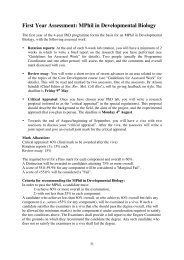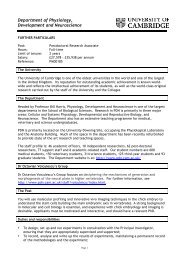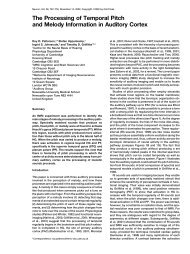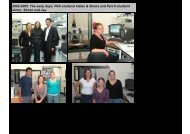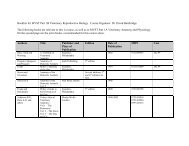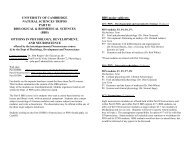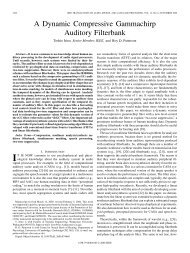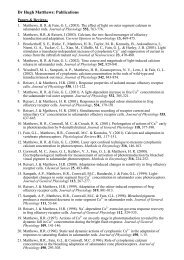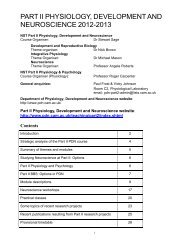Self-report outcome in new hearing-aid users - Department of ...
Self-report outcome in new hearing-aid users - Department of ...
Self-report outcome in new hearing-aid users - Department of ...
Create successful ePaper yourself
Turn your PDF publications into a flip-book with our unique Google optimized e-Paper software.
Alexander (2002) for a group <strong>of</strong> subjects <strong>in</strong> the Americas, and by<br />
Stephens (2002) for a group <strong>of</strong> English-speak<strong>in</strong>g patients <strong>in</strong><br />
Wales, and <strong>in</strong> a Dutch translation by Kramer et al (2002). The<br />
authors identified two <strong>in</strong>dependent subscales that will here be<br />
designated Introspection and Interaction, as suggested by Cox<br />
and Alexander (2002).<br />
HAPQ uses a visual analogue scale for 18 items address<strong>in</strong>g<br />
contentment with hear<strong>in</strong>g <strong>aid</strong>s <strong>in</strong> various specific listen<strong>in</strong>g<br />
situations. Previous work with this questionnaire at the Research<br />
Centre Eriksholm, has <strong>in</strong>dicated that between one and five<br />
<strong>in</strong>dependent subscales can be derived from the responses to the<br />
18 questions.<br />
SADL consists <strong>of</strong> 15 items on hear<strong>in</strong>g-<strong>aid</strong> performance and<br />
user satisfaction, and four additional questions concern<strong>in</strong>g<br />
hear<strong>in</strong>g-<strong>aid</strong> experience and use. Cox & Alexander (1999) found<br />
that SADL comprised four subscales, which they labelled<br />
positive effect, service and cost, negative features, and personal<br />
image (Cox & Alexander, 2001). The SADL subscales are largely<br />
<strong>in</strong>dependent, as is also the case for the IOI-HA subscales,<br />
arguably due to the extraction method that <strong>in</strong> all cases was based<br />
on <strong>in</strong>dependent component analysis (Cox & Alexander, 2002;<br />
Kramer et al, 2002; Stephens, 2002).<br />
ALD is a questionnaire <strong>in</strong>tended to assess the richness <strong>of</strong> the<br />
auditory environments <strong>in</strong> which <strong>in</strong>dividuals are required to<br />
function (Gatehouse, 1999a). The questionnaire presents 25<br />
listen<strong>in</strong>g situations, and for each situation subjects were asked to<br />
<strong>in</strong>dicate how <strong>of</strong>ten the situation occurred and how important it<br />
was. Gatehouse found a high correlation between ALD scores<br />
and the variability <strong>of</strong> sound levels encountered dur<strong>in</strong>g the day by<br />
listeners wear<strong>in</strong>g a dosimeter (a sound-level logg<strong>in</strong>g device).<br />
Danish translations <strong>of</strong> the five questionnaires were used.<br />
GHABP comes <strong>in</strong> an <strong>of</strong>ficial Danish version, which is distributed<br />
via the website <strong>of</strong> the Institute <strong>of</strong> Hear<strong>in</strong>g Research (www.ihr.-<br />
gla.ac.uk). IOI-HA has also been presented <strong>in</strong> an <strong>of</strong>ficial Danish<br />
translation (Cox et al, 2002); however neither GHABP nor IOI-<br />
HA has yet been validated <strong>in</strong> the Danish versions. HAPQ and<br />
ALD have been used <strong>in</strong> Danish <strong>in</strong> several unpublished studies<br />
at the Research Centre, Eriksholm. Only SADL was not available<br />
<strong>in</strong> Danish prior to the experiment. SADL was translated <strong>in</strong>to<br />
Danish by the author <strong>of</strong> the present paper and translated back<br />
by a native English speaker who had no a priori expertise <strong>in</strong><br />
SADL, so as to validate the Danish translation, as suggested by<br />
Arl<strong>in</strong>ger (2000). The English and Danish word<strong>in</strong>gs are given<br />
<strong>in</strong> Vestergaard (2004). 1 It should be mentioned that while the<br />
ALD version used <strong>in</strong> this study is the questionnaire orig<strong>in</strong>ally<br />
devised by Gatehouse, he left out item 9 <strong>in</strong> his later studies<br />
(Gatehouse, 1999a; Gatehouse et al, 2000).<br />
Subjects<br />
Twenty five subjects were recruited from an audiological cl<strong>in</strong>ic at<br />
a local hospital. They had steeply-slop<strong>in</strong>g hear<strong>in</strong>g losses with an<br />
average (and standard deviation) slope <strong>of</strong> 55 dB/oct (s.d. 17 dB/<br />
oct) and an average corner frequency <strong>of</strong> 1255 Hz (s.d. 595 Hz).<br />
The corner frequency for each ear was determ<strong>in</strong>ed by visual<br />
<strong>in</strong>spection <strong>of</strong> a hear<strong>in</strong>g-threshold curve measured with 1/6th oct<br />
frequency resolution. At the corner frequency, the average<br />
hear<strong>in</strong>g threshold was 14 dB HL 2 (s.d. 10 dB HL).<br />
Figure 1 shows the range <strong>of</strong> HL values for the participants<br />
along with a typical audiogram. Three women and 22 men with<br />
an average age <strong>of</strong> 60.4 years (s.d. 10.8 yrs) took part. Five<br />
Hear<strong>in</strong>g threshold (dB HL)<br />
0<br />
20<br />
40<br />
60<br />
80<br />
100<br />
120<br />
0.1 0.2 0.5 1 2 5 10<br />
Frequency (kHz)<br />
Figure 1. Range <strong>of</strong> hear<strong>in</strong>g threshold levels <strong>of</strong> the subjects and<br />
key audiometric values with standard deviation bars (9/s.d.).<br />
The typical audiogram is composed by connect<strong>in</strong>g with straight<br />
l<strong>in</strong>es the follow<strong>in</strong>g key audiometric po<strong>in</strong>ts through the average<br />
values: Hear<strong>in</strong>g level (HL) at 250 Hz, HL at the corner<br />
frequency, HL one octave above the corner frequency and HL<br />
at 8000 Hz.<br />
subjects had previous hear<strong>in</strong>g-<strong>aid</strong> experience while 20 were firsttime<br />
<strong>users</strong>.<br />
Protocol<br />
A week before the assessments started, the subjects were<br />
bilaterally fitted with <strong>new</strong> hear<strong>in</strong>g <strong>aid</strong>s, provided at no cost.<br />
The subjects filled <strong>in</strong> the <strong>outcome</strong> questionnaires three times,<br />
one week, four weeks and 13 weeks post-fitt<strong>in</strong>g. They were<br />
<strong>in</strong>structed to fill <strong>in</strong> the questionnaires on their own, the night<br />
before each session, but at each session, the experimenter was<br />
available to assist the subjects <strong>in</strong> case <strong>of</strong> any doubts regard<strong>in</strong>g<br />
the mean<strong>in</strong>g <strong>of</strong> the items. This was done to reduce potential bias<br />
<strong>of</strong> the results caused by the experimenter be<strong>in</strong>g <strong>in</strong>volved <strong>in</strong> the<br />
scor<strong>in</strong>g process, while limit<strong>in</strong>g the number <strong>of</strong> items left<br />
unanswered. ALD was adm<strong>in</strong>istered before HA fitt<strong>in</strong>g and<br />
repeated 13 weeks post-fitt<strong>in</strong>g. This schedule was optimized for<br />
the larger-scale study (Vestergaard, 2004) <strong>in</strong> which the assessments<br />
took place.<br />
For GHABP, items concern<strong>in</strong>g <strong>in</strong>itial disability and handicap<br />
were filled <strong>in</strong> dur<strong>in</strong>g the <strong>in</strong>troduction to the questionnaire. In<br />
subsequent presentations <strong>of</strong> the questionnaire, these answers<br />
were carried forward to give the subjects the possibility <strong>of</strong><br />
recall<strong>in</strong>g their <strong>in</strong>itial references. For SADL, items 14 and 15 were<br />
not used because they address cost and reliability <strong>of</strong> the hear<strong>in</strong>g<br />
<strong>in</strong>struments, issues that were expected to be irrelevant when<br />
evaluat<strong>in</strong>g a <strong>new</strong> hear<strong>in</strong>g <strong>in</strong>strument provided at no cost.<br />
Hear<strong>in</strong>g <strong>aid</strong>s<br />
The hear<strong>in</strong>g <strong>aid</strong>s were Oticon Adapto. It is a programmable<br />
automatic multi-band <strong>in</strong>strument with two-channel compression<br />
and no volume control. They were programmed with the<br />
manufacturer’s fitt<strong>in</strong>g s<strong>of</strong>tware, ‘Genie’, to a modified version<br />
<strong>of</strong> the proprietary fitt<strong>in</strong>g rationale ‘SKI’. With the SKI rationale,<br />
384 International Journal <strong>of</strong> Audiology, Volume 45 Number 7



